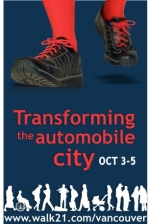Fastcoexist.com weighs in on something we all think about: is the way to stop vehicular crashes a design one? Should we be insisting that engineers design better roads? The answer is yes, by slimming vehicle lanes down, factored in with the magical ingredient of slower speeds.
Slower cars means safer roads, and while adding speed cameras and reducing speed limits can help, nothing beats a design that stops drivers from speeding in the first place. Also, slower cars mean less injury in the case of a collision, but again, avoiding the collision to begin with is even better.
Alon Levy, writing for Pedestrian Observations, makes the argument for better infrastructure. One of the main causes of accidents is driver fatigue and sleepiness, which is in turn caused in large part by monotony. “It is better to design roads to have more frequent stimuli: trees, sidewalks with pedestrians, commercial development, [and] residential development,” writes Levy. Another trick is to make lanes narrower. Drivers speed up in wider lanes, and they’re also pedestrian-hostile, making it harder to cross streets safely. Narrowing them helps in both cases, and could create more space at the side of the road for bigger sidewalks or wider bike lanes.
Levy cites Sweden as a good example of road redistribution. In Stockholm, the few arterial roadways in the city have “seen changes giving away space from cars to public transit and pedestrians.” Many roads only have one lane in each direction for cars, with other lanes given over to pedestrians, buses, and bikes. Levy also covers “setbacks,” the wasted land in front of a building that sets it back from the road. Some U.S. zoning laws mandate these setbacks, and these should be repealed, for a more pedestrian-friendly space.
The article also discusses the use of bollards to cut off residential streets used by short cutting commuter traffic, which also allows cyclists and pedestrians better and safer use of the street. But these changes require knowledgeable politicians and citizen resolve-those decisions require a political will that is often too weak in the face of bullying from car drivers. Design may be more important than enforcement, then, but it’s strong politics that will make those changes.



